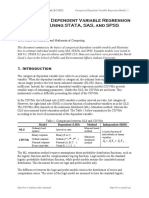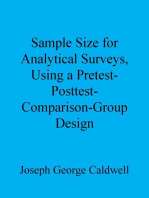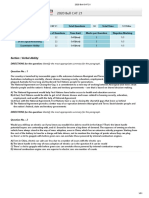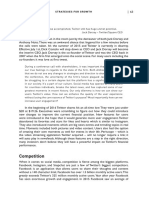Assignment On Probit Model
Uploaded by
Nidhi KaushikAssignment On Probit Model
Uploaded by
Nidhi KaushikASSIGNMENT ON PROBIT MODEL
In statistics, a probit model is a type of regression where
the dependent variable can take only two values, for
example married or not married.
The word is a portmanteau, coming from probability +
unit.
The purpose of the model is to estimate the probability
that an observation with particular characteristics will
fall into a specific one of the categories; moreover,
classifying observations based on their predicted
probabilities is a type of binary classification model.
A probit model is a popular specification for a binary
response model.
As such it treats the same set of problems as does
logistic regression using similar techniques.
When viewed in the generalized linear model
framework, the probit model employs a probit link
function. It is most often estimated using the maximum
likelihood procedure, such an estimation being called a
probit regression.
CONCEPTUAL FRAMEWORK
Suppose a response variable Y is binary, that is it can have
only two possible outcomes which we will denote as 1 and 0.
For example, Y may represent presence/absence of a certain
condition, success/failure of some device, answer yes/no on
a survey, etc. We also have a vector of regressors X, which
are assumed to influence the outcome Y. Specifically; we
assume that the model takes the form:
Where Pr denotes probability and Φ is the Cumulative
Distribution Function (CDF) of the standard normal
distribution. The parameters β are typically estimated by
maximum likelihood.
It is possible to motivate the probit model as a latent variable
model. Suppose there exists an auxiliary random variable:
{\ where ε ~ N (0, 1).
Then Y can be viewed as an indicator for whether this latent
variable is positive:
The use of the standard normal distribution causes no loss of
generality compared with the use of a normal distribution
with an arbitrary mean and standard deviation, because
adding a fixed amount to the mean can be compensated by
subtracting the same amount from the intercept, and
multiplying the standard deviation by a fixed amount can be
compensated by multiplying the weights by the same
amount.
To see that the two models are equivalent, note that
MODEL ESTIMATION THROUGH MAXIMUM LIKELIHOOD
METHOD
Suppose data set
contains ‘n’ independent statistical units corresponding to
the model above.
For the single observation, conditional on the vector of
inputs of that observation, we have:
Where xi is a vector of inputs, and β is a ( ) vector of
coefficients.
The likelihood of a single observation (yi,xi) is then
In fact, if yi =1, then
Since the observations are independent and identically
distributed, then the likelihood of the entire sample, or the
joint likelihood, will be equal to the product of the likelihoods
of the single observations:
The joint log-likelihood function is thus:
The estimator which maximizes this function will be
consistent, asymptotically normal and efficient provided that
E[XX'] exists and is not singular. It can be shown that this log-
likelihood function is globally concave in β, and therefore
standard numerical algorithms for optimization will converge
rapidly to the unique maximum.
Asymptotic distribution for β hat is given by
And is the Probability Density Function (PDF) of
standard normal distribution.
PROBIT MODEL OR LOGIT MODEL?
The logit and probit predictors can be written as:
Y^=f (α+βx)
Logit and probit differ in how they define f (∗).
The logit model uses the cumulative distribution function of
the logistic distribution.
The probit model uses the cumulative distribution function of
the standard normal distribution to define f (∗).
Both functions will take any number and rescale it to fall
between 0 and 1.
Hence, whatever α + βx equals; it can be transformed by the
function to yield a predicted probability. Any function that
would return a value between zero and one can work.
But there is a deeper theoretical model underpinning logit
and probit that requires the function to be based on a
probability distribution.
The logistic and standard normal cdf turn out to be
convenient mathematically and are programmed into just
about any general purpose statistical package.
Is logit better than probit, or vice versa? Both methods will
yield similar (though not identical) inferences. Logit – also
known as logistic regression – is more popular in health
sciences like epidemiology partly because coefficients can be
interpreted in terms of odds ratios. Probit models can be
generalized to account for non-constant error variances in
more advanced econometric settings (known as
heteroskedastic probit models) and hence are used in some
contexts by economists and political scientists. If these more
advanced applications are not of relevance, than it does not
matter which method you choose to go with.
PRACTICAL APPLICATION
Research Question: We need to check the likelihood of
admission based on the GRE score, GPA and the rank of the
institution.
This data set has a binary response (outcome,
dependent) variable called admit.
There are three predictor variables: gre, gpa and rank.
We will treat the variables gre and gpa as continuous.
The variable rank takes on the values 1 through 4.
Institutions with a rank of 1 have the highest prestige,
while those with a rank of 4 have the lowest.
REGRESSION RESULTS:
Call:
glm (formula = admit ~ gre + gpa + rank, family = binomial (link = "
probit"),
Data = binary)
Deviance Residuals:
Min 1Q Median 3Q Max
-1.6163 -0.8710 -0.6389 1.1560 2.1035
Coefficients:
Estimate Std. Error z value Pr (>|z|)
(Intercept) -2.386836 0.673946 -3.542 0.000398 ***
gre 0.001376 0.000650 2.116 0.034329 *
gpa 0.477730 0.197197 2.423 0.015410 *
rank2 -0.415399 0.194977 -2.131 0.033130 *
rank3 -0.812138 0.208358 -3.898 9.71e-05 ***
rank4 -0.935899 0.245272 -3.816 0.000136 ***
---
Signif. codes: 0 ‘***’ 0.001 ‘**’ 0.01 ‘*’ 0.05 ‘.’ 0.1 ‘ ’ 1
(Dispersion parameter for binomial family taken to be 1)
Null deviance: 499.98 on 399 degrees of freedom
Residual deviance: 458.41 on 394 degrees of freedom
AIC: 470.41
Number of Fisher Scoring iterations: 4
Interpretation:
In the output above, the first thing we see is the call,
this is R reminding us what the model we ran was, what
options we specified, etc.
Next we see the deviance residuals, which are a
measure of model fit. This part of output shows the
distribution of the deviance residuals for individual cases
used in the model. Below we discuss how to use
summaries of the deviance statistic to asses model fit.
The next part of the output shows the coefficients, their
standard errors, the z-statistic (sometimes called a Wald
z-statistic), and the associated p-values.
Both gre, gpa, and the three terms for rank are
statistically significant.
The probit regression coefficients give the change in the
z-score or probit index for a one unit change in the
predictor.
For a one unit increase in GRE, the z-score increases by
0.001.
For each one unit increase in GPA, the z-score increases
by 0.478.
The indicator variables for rank have a slightly different
interpretation. For example, having attended an
undergraduate institution of rank of 2, versus an
institution with a rank of 1, decreases the z-score by
0.415.
WALD TEST
Explanation:
The Wald test (also called the Wald Chi-Squared Test) is
a way to find out if explanatory variables in a model are
significant.
“Significant” means that they add something to the
model; variables that add nothing can be deleted
without affecting the model in any meaningful way.
The null hypothesis for the test is: some parameter =
some value. For example, you might be studying if
weight is affected by eating junk food twice a week.
“Weight” would be your parameter. The value could be
zero (indicating that you don’t think weight is affected
by eating junk food).
If the null hypothesis is rejected, it suggests that the
variables in question can be removed without much
harm to the model fit.
If the Wald test shows that the parameters for certain
explanatory variables are zero, you can remove the
variables from the model.
If the test shows the parameters are not zero, you
should include the variables in the model.
RELEVANCE OF WALD TEST:
It is sometimes said that the prestige of the institution
mayn’t be well expressed in terms of the rank of the
institution.
Hence, we need to check the overall impact of rank on
the model through Wald Test
RESULTS
Wald test:
----------
Chi-squared test:
X2 = 21.4, df = 3, P(> X2) = 8.9e-05
Interpretation: The chi-squared test statistic of 21.4 with
three degrees of freedom is associated with a p-value of less
than 0.001 indicating that the overall effect of rank is
statistically significant.
PREDICTING PROBABILITIES:
We have tried to present the predicted
probabilities in a graphical manner for better
understanding
Four plots were created each for different level of
GPA, i.e., 2.5, 3, 3.5 and 4
The color of lines indicate the rank the predicted
probabilities are meant for
TESTING FOR FIT OF THE MODEL
Herein, we are going to adopt a new approach to test
the fit of the model wherein we will take the overall fit
of the model in consideration.
This test asks whether the model with predictors fits
significantly better than a model with just an intercept
(i.e. a null model).
The test statistic is the difference between the residual
deviance for the model with predictors and the null
model.
The test statistic is distributed chi-squared with degrees
of freedom equal to the differences in degrees of
freedom between the current and the null model (i.e.
the number of predictor variables in the model).
To find the difference in deviance for the two models
(i.e. the test statistic) we can compute the change in
deviance, and test it using a chi square test—the change
in deviance distributed as chi square on the change in
degrees of freedom.
RESULTS
CHANGE IN
• 41.56335
DEVIANCE
DEGREES OF
•5
FREEDOM
CHI SQUARED
• 7.218932e-08
P-VALUE
INTERPRETATION
The chi-square of 41.56 with 5 degrees of freedom and
an associated p-value of less than 0.001 tells us that our
model as a whole fits significantly better than an empty
model.
This is also called a likelihood ratio test
CONCLUSIONS:
Probit models simply use the cumulative Gaussian
normal distribution rather than the logistic function for
calculating the probability of being in one category or
not.
Graphical analysis of predicted values can help in better
understanding of the model and results
The theoretical and statistical analysis must go hand in
hand while developing a model, otherwise false
conclusions may be drawn.
Theoretical evidence and justification for omission or
involvement of variables in the model should be
supported with statistical evidence.
While testing the fit of the model, the overall fit of the
model should be considered, so that every aspect of the
model is considered and is in line with the final
conclusion so drawn.
You might also like
- (Oxford World's Classics) Euripides, James Morwood, Edith Hall - The Trojan Women and Other Plays-Oxford University Press (2009) PDF92% (12)(Oxford World's Classics) Euripides, James Morwood, Edith Hall - The Trojan Women and Other Plays-Oxford University Press (2009) PDF939 pages
- A Gestalt Therapy Approach To Shame and Self100% (4)A Gestalt Therapy Approach To Shame and Self20 pages
- Logit Regression - R Data Analysis ExamplesNo ratings yetLogit Regression - R Data Analysis Examples12 pages
- Regression With A Binary Dependent VariableNo ratings yetRegression With A Binary Dependent Variable63 pages
- Limited Dependent Variables - Binary Dependent VariablesNo ratings yetLimited Dependent Variables - Binary Dependent Variables24 pages
- Newsletter 23 - Logit, Probit, Tobit (2P)No ratings yetNewsletter 23 - Logit, Probit, Tobit (2P)2 pages
- L9 Logistical Regression Models UpdatedNo ratings yetL9 Logistical Regression Models Updated10 pages
- Logit, Probit and Multinomial Logit Models in R: Oscar Torres-ReynaNo ratings yetLogit, Probit and Multinomial Logit Models in R: Oscar Torres-Reyna27 pages
- Logit, Probit and Multinomial Logit Models in R: Oscar Torres-ReynaNo ratings yetLogit, Probit and Multinomial Logit Models in R: Oscar Torres-Reyna24 pages
- Unitb - II - Linear Probability, Logit and ProbitNo ratings yetUnitb - II - Linear Probability, Logit and Probit34 pages
- Chapter 15 Qualitative Response Regression Models Part 2No ratings yetChapter 15 Qualitative Response Regression Models Part 231 pages
- Fernando, Logit Tobit Probit March 2011No ratings yetFernando, Logit Tobit Probit March 201119 pages
- Logit Probit and Tobit Models For Catego PDFNo ratings yetLogit Probit and Tobit Models For Catego PDF19 pages
- Chapter 6. Limited dependent variable models FINALNo ratings yetChapter 6. Limited dependent variable models FINAL16 pages
- Econometria Avanzada: Generalized Linear ModelsNo ratings yetEconometria Avanzada: Generalized Linear Models30 pages
- Alternatives To Logistic Regression (Brief Overview)No ratings yetAlternatives To Logistic Regression (Brief Overview)5 pages
- Categorical Dependent Variable Regression Models Using STATA, SAS, and SPSSNo ratings yetCategorical Dependent Variable Regression Models Using STATA, SAS, and SPSS32 pages
- Sample Size for Analytical Surveys, Using a Pretest-Posttest-Comparison-Group DesignFrom EverandSample Size for Analytical Surveys, Using a Pretest-Posttest-Comparison-Group DesignNo ratings yet
- Introduction To Econometrics - Stock & Watson - CH 9 Slides100% (1)Introduction To Econometrics - Stock & Watson - CH 9 Slides69 pages
- A Simple But Effective Logistic Regression DerivationNo ratings yetA Simple But Effective Logistic Regression Derivation6 pages
- Logistic Regression: Continued Psy 524 Ainsworth0% (1)Logistic Regression: Continued Psy 524 Ainsworth29 pages
- BSC Intermediate Econometrics: Please Do Not DistributeNo ratings yetBSC Intermediate Econometrics: Please Do Not Distribute25 pages
- Modelos - Sem15 - Logit - Probit - Logistic RegressionNo ratings yetModelos - Sem15 - Logit - Probit - Logistic Regression8 pages
- 26GeneralizedLinearModelBernoulliAnnotated PDFNo ratings yet26GeneralizedLinearModelBernoulliAnnotated PDF46 pages
- Process Performance Models: Statistical, Probabilistic & SimulationFrom EverandProcess Performance Models: Statistical, Probabilistic & SimulationNo ratings yet
- Multi-dimensional Monte Carlo Integrations Utilizing MathematicaFrom EverandMulti-dimensional Monte Carlo Integrations Utilizing MathematicaNo ratings yet
- 2020 Bull CAT 21: Section: Verbal AbilityNo ratings yet2020 Bull CAT 21: Section: Verbal Ability51 pages
- Mutual Funds: Answer Role of Mutual Funds in The Financial Market: Mutual Funds Have Opened New Vistas To100% (1)Mutual Funds: Answer Role of Mutual Funds in The Financial Market: Mutual Funds Have Opened New Vistas To43 pages
- Notional Amount: Maturity:: Plain Vanilla Interest Rate SwapNo ratings yetNotional Amount: Maturity:: Plain Vanilla Interest Rate Swap2 pages
- Chapter 17. Tool Kit For Financial Options and Real Options With The TAB Labeled "Real Options."No ratings yetChapter 17. Tool Kit For Financial Options and Real Options With The TAB Labeled "Real Options."30 pages
- Overall Returns 11.100% Risk 3.6359% Weights 0.3744394619 MVP Returns 11.18% Correlation - 0.678146 Risk MVP 3.4755%No ratings yetOverall Returns 11.100% Risk 3.6359% Weights 0.3744394619 MVP Returns 11.18% Correlation - 0.678146 Risk MVP 3.4755%2 pages
- What's The Use of A Fine House If You Haven't Got A Tolerable Planet To Put It On."No ratings yetWhat's The Use of A Fine House If You Haven't Got A Tolerable Planet To Put It On."2 pages
- Target constants for Leica Total StationNo ratings yetTarget constants for Leica Total Station4 pages
- Advances in Adaptive Control Theory GradNo ratings yetAdvances in Adaptive Control Theory Grad165 pages
- On The Method of Ship's Transoceanic Route PlanningNo ratings yetOn The Method of Ship's Transoceanic Route Planning8 pages
- Thielman v. Fagan Complaint, Case No. 3:22-CV-01516-SBNo ratings yetThielman v. Fagan Complaint, Case No. 3:22-CV-01516-SB44 pages
- tc1972en-ed05_limits_and_dimensioning_for_omnipcx_office_rce_release_10.3No ratings yettc1972en-ed05_limits_and_dimensioning_for_omnipcx_office_rce_release_10.316 pages
- Owner's Manual: Gas-Fired Infra-Red Heater Models: SHR35, 50, 75 & 100-X/N/L-1No ratings yetOwner's Manual: Gas-Fired Infra-Red Heater Models: SHR35, 50, 75 & 100-X/N/L-117 pages
- 2024 Stanford cs25 Guest Lecture Jason WeiNo ratings yet2024 Stanford cs25 Guest Lecture Jason Wei20 pages
- Design Requirements.: Design of Pre Engineered BuildingsNo ratings yetDesign Requirements.: Design of Pre Engineered Buildings2 pages
- Definition of Distribution Logistics From The Producer To The CustomerNo ratings yetDefinition of Distribution Logistics From The Producer To The Customer2 pages
- (Oxford World's Classics) Euripides, James Morwood, Edith Hall - The Trojan Women and Other Plays-Oxford University Press (2009) PDF(Oxford World's Classics) Euripides, James Morwood, Edith Hall - The Trojan Women and Other Plays-Oxford University Press (2009) PDF
- Limited Dependent Variables - Binary Dependent VariablesLimited Dependent Variables - Binary Dependent Variables
- Logit, Probit and Multinomial Logit Models in R: Oscar Torres-ReynaLogit, Probit and Multinomial Logit Models in R: Oscar Torres-Reyna
- Logit, Probit and Multinomial Logit Models in R: Oscar Torres-ReynaLogit, Probit and Multinomial Logit Models in R: Oscar Torres-Reyna
- Chapter 15 Qualitative Response Regression Models Part 2Chapter 15 Qualitative Response Regression Models Part 2
- Chapter 6. Limited dependent variable models FINALChapter 6. Limited dependent variable models FINAL
- Alternatives To Logistic Regression (Brief Overview)Alternatives To Logistic Regression (Brief Overview)
- Categorical Dependent Variable Regression Models Using STATA, SAS, and SPSSCategorical Dependent Variable Regression Models Using STATA, SAS, and SPSS
- Sample Size for Analytical Surveys, Using a Pretest-Posttest-Comparison-Group DesignFrom EverandSample Size for Analytical Surveys, Using a Pretest-Posttest-Comparison-Group Design
- Introduction To Econometrics - Stock & Watson - CH 9 SlidesIntroduction To Econometrics - Stock & Watson - CH 9 Slides
- A Simple But Effective Logistic Regression DerivationA Simple But Effective Logistic Regression Derivation
- BSC Intermediate Econometrics: Please Do Not DistributeBSC Intermediate Econometrics: Please Do Not Distribute
- Modelos - Sem15 - Logit - Probit - Logistic RegressionModelos - Sem15 - Logit - Probit - Logistic Regression
- Process Performance Models: Statistical, Probabilistic & SimulationFrom EverandProcess Performance Models: Statistical, Probabilistic & Simulation
- Multi-dimensional Monte Carlo Integrations Utilizing MathematicaFrom EverandMulti-dimensional Monte Carlo Integrations Utilizing Mathematica
- Mutual Funds: Answer Role of Mutual Funds in The Financial Market: Mutual Funds Have Opened New Vistas ToMutual Funds: Answer Role of Mutual Funds in The Financial Market: Mutual Funds Have Opened New Vistas To
- Notional Amount: Maturity:: Plain Vanilla Interest Rate SwapNotional Amount: Maturity:: Plain Vanilla Interest Rate Swap
- Chapter 17. Tool Kit For Financial Options and Real Options With The TAB Labeled "Real Options."Chapter 17. Tool Kit For Financial Options and Real Options With The TAB Labeled "Real Options."
- Overall Returns 11.100% Risk 3.6359% Weights 0.3744394619 MVP Returns 11.18% Correlation - 0.678146 Risk MVP 3.4755%Overall Returns 11.100% Risk 3.6359% Weights 0.3744394619 MVP Returns 11.18% Correlation - 0.678146 Risk MVP 3.4755%
- What's The Use of A Fine House If You Haven't Got A Tolerable Planet To Put It On."What's The Use of A Fine House If You Haven't Got A Tolerable Planet To Put It On."
- On The Method of Ship's Transoceanic Route PlanningOn The Method of Ship's Transoceanic Route Planning
- Thielman v. Fagan Complaint, Case No. 3:22-CV-01516-SBThielman v. Fagan Complaint, Case No. 3:22-CV-01516-SB
- tc1972en-ed05_limits_and_dimensioning_for_omnipcx_office_rce_release_10.3tc1972en-ed05_limits_and_dimensioning_for_omnipcx_office_rce_release_10.3
- Owner's Manual: Gas-Fired Infra-Red Heater Models: SHR35, 50, 75 & 100-X/N/L-1Owner's Manual: Gas-Fired Infra-Red Heater Models: SHR35, 50, 75 & 100-X/N/L-1
- Design Requirements.: Design of Pre Engineered BuildingsDesign Requirements.: Design of Pre Engineered Buildings
- Definition of Distribution Logistics From The Producer To The CustomerDefinition of Distribution Logistics From The Producer To The Customer













































































































